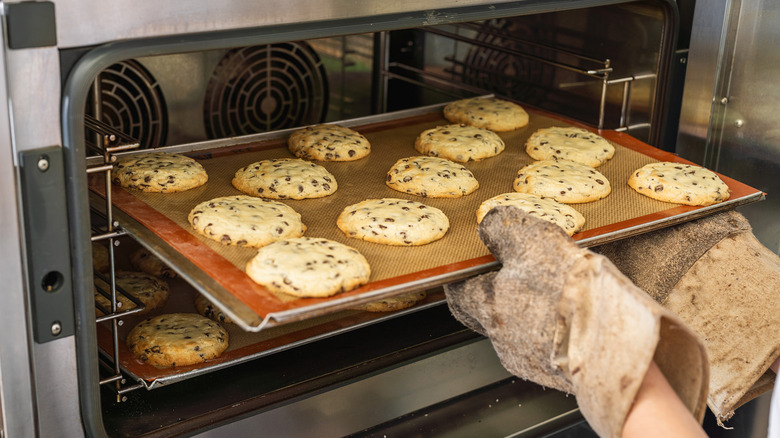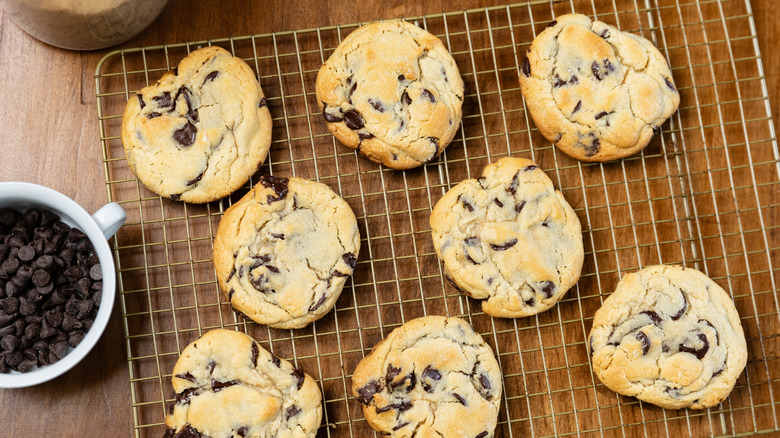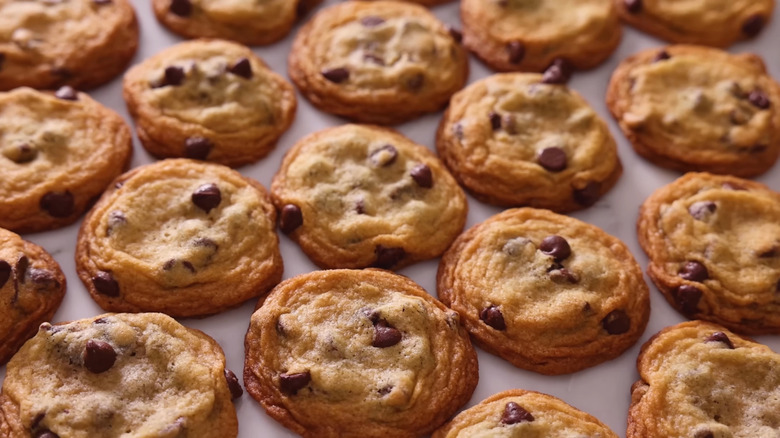Here's What To Do If Your Cookies Aren't Browning
You probably know someone who makes simply the best cookies imaginable. Heck, maybe you're that someone! But, if anyone were to say they've never baked an off-color batch of cookies, that would be a blatant lie. At some point, we've all overbaked, underbaked, or worse. Sometimes the cookies are too dark on the bottom, too hard, too salty, too raw in the middle, or they spread out to make one giant cookie abomination. While you may easily be able to figure out how to fix cookies that come out flat or other similar issues, there's one problem that's a little more complicated: pale cookies. Figuring out cookies that simply refuse to brown can be an absolute nightmare.
The truth is, there are numerous factors that could lead to pale cookies. Sometimes it might have to do with which ingredients you use or the amount of them, so you could use more of a higher-quality sweetener to speed up proper caramelization. It might even have to do with the cook time or your oven itself, in which case a different pan could help with uneven baking. Whatever the root cause, unbrowned cookies are luckily a fixable problem. You just have to understand the science before you start troubleshooting.
It all has to do with chemical reactions
Rather than being straightforward, like the science behind baking soda in cookies, the chemical reactions involved in browning have many components. First, getting the right taste, texture, and color is, in large part, caramelization. Caramelization happens when sweeteners are heated up until they break down, turning them golden or brown. It also creates a crispy bottom when cookies are placed on the right type of baking sheet. Caramelized sugar provides rich, buttery notes, but if it isn't heated highly or evenly enough, it retains its original color and taste. Many cookie recipes call for white sugar, meaning that when uncaramelized, these cookies stay pale.
The other major factor is a phenomenon called the Maillard reaction. Simplified, this once again has to do with high temperatures breaking down substances — in this case amino acids and sugars such as glucose or fructose — resulting in browning. Depending on the proteins and pH levels in your dough, your cookies need various bake times and temperatures for this reaction to occur. In other words, the wrong amounts of eggs, fats, and sweeteners can leave a batch of cookies nearly white.
If neither caramelization nor the Maillard reaction happens properly, you notice it not only in the color, but in the taste. Your cookies may lack complexity without rich, nutty notes, or they may not taste baked or could seem bland when bitten into. If you notice these telltale signs, you now know where the problem lies.
How to get them golden
With so many possibilities as to why these reactions aren't happening, a little trial and error is needed. Just as you must try a bunch of options when applying new tricks or add-ins to spruce up chocolate chip cookies, you need to cast a wide net to find the source of this problem.
Initially, consider what tools you're using. This is especially true if your recipe has worked in the past, but is suddenly faltering without any changes to ingredients. Dark-colored baking sheets that aren't insulated may brown the bottoms of your cookies faster than the tops can cook, leaving a dark bottom and a very pale, raw top. Select a large insulated baking sheet instead, preferably made of stainless steel or aluminum, and place it on the center rack of your oven. For some types of cookies, parchment paper may also help prevent uneven baking. If all of this still leaves you with dark bottoms and light tops, your oven may not be heating properly and could do with a good cleaning or calibrating.
Should you find your tools are not at fault, examine your ingredient types and quantities. Some sweeteners, such as maple syrup, don't caramelize as quickly as sugar, so cookies with this sweetener may be reluctant to brown. Too much liquid or not enough eggs can slow the Maillard reaction and prevent browning as well. Not enough sugar means flavorless cookies and not enough caramelization. To know for sure, tweak these ingredient amounts one by one until you get what you're after. Once you have the ideal cookie color and taste, remember to use bread when storing your cookies to keep them fresh long enough to share.


